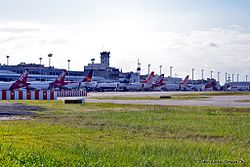Santos Dumont airport
|
Santos Dumont Airport Aeroporto Santos Dumont |
|||||||||||||||
|---|---|---|---|---|---|---|---|---|---|---|---|---|---|---|---|
 |
|||||||||||||||
| Summary | |||||||||||||||
| Airport type | Public/Military | ||||||||||||||
| Operator | Infraero | ||||||||||||||
| Serves | Rio de Janeiro | ||||||||||||||
| Focus city for | Azul Brazilian Airlines | ||||||||||||||
| Elevation AMSL | 3 m / 11 ft | ||||||||||||||
| Coordinates | 22°54′37″S 043°09′46″W / 22.91028°S 43.16278°WCoordinates: 22°54′37″S 043°09′46″W / 22.91028°S 43.16278°W | ||||||||||||||
| Website | Infraero SDU | ||||||||||||||
| Map | |||||||||||||||
| Location within greater Rio de Janeiro | |||||||||||||||
| Runways | |||||||||||||||
|
|||||||||||||||
| Statistics (2015) | |||||||||||||||
|
|||||||||||||||
|
Statistics: Infraero
Sources: Airport Website,ANAC |
|||||||||||||||
| Passengers | 9,618,197 |
|---|---|
| Aircraft operations | 120,538 |
| Metric tonnes of cargo | 2,892 |
Santos Dumont Airport (IATA: SDU, ICAO: SBRJ) is the second major airport serving Rio de Janeiro, Brazil. It is named after the Brazilian aviation pioneer Alberto Santos Dumont (1873–1932). It is operated by Infraero.
Santos Dumont has slot restrictions operating with a maximum of 19 operations/hour, being one of the five airports with such restrictions in Brazil.
Originally known as Calabouço Airport, the history of the airport can be traced back to the early 1930s. Until that time,the few aircraft equipped with landing gear used Manguinhos Airport. Seaplanes, which at the time operated the majority of domestic and international flights, used a terminal located at the Calabouço Point, an area known today as Praça Marechal Âncora. Take-off and landings were made using an area of Guanabara Bay then known as estirão do Caju (Caju water stretch). It was as a development of the terminal at Calabouço Point that Calabouço Airport was created.
A new public terminal building for seaplanes was inaugurated on 29 October 1938. It was a replacement for the original passenger terminal and was used by all airlines except Panair do Brasil and Pan American World Airways, which used their own facilities. Due to the obsolescence of seaplanes, it ceased to be used in 1942. Today, this protected building houses the Historical and Cultural Institute of the Brazilian Air Force (INCAER).
In 1934, in order to handle a growing amount of land operations, land was reclaimed from the sea to create the first runway of the airport with a length of 1,300 feet (400 m). In 1936, the runway was extended to 2,300 feet (700 m) and on 30 November it received its first commercial flight, a VASP Junkers Ju 52 aircraft flying from São Paulo–Congonhas. The airport complex was inaugurated on 16 October 1936 and was named Santos Dumont Airport.
...
Wikipedia

